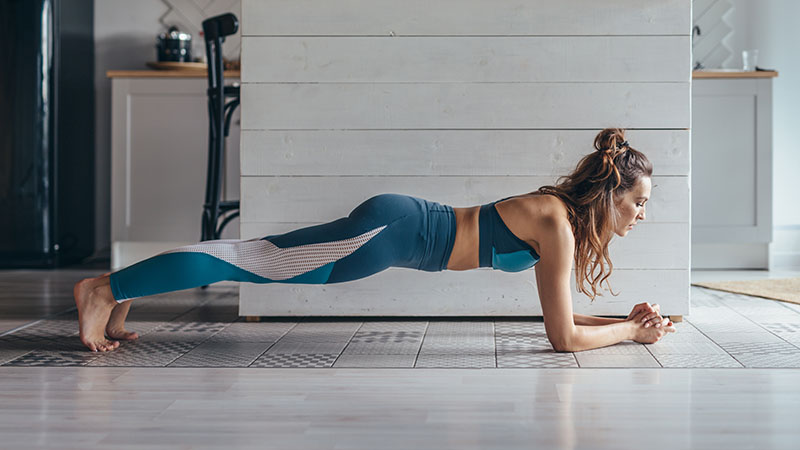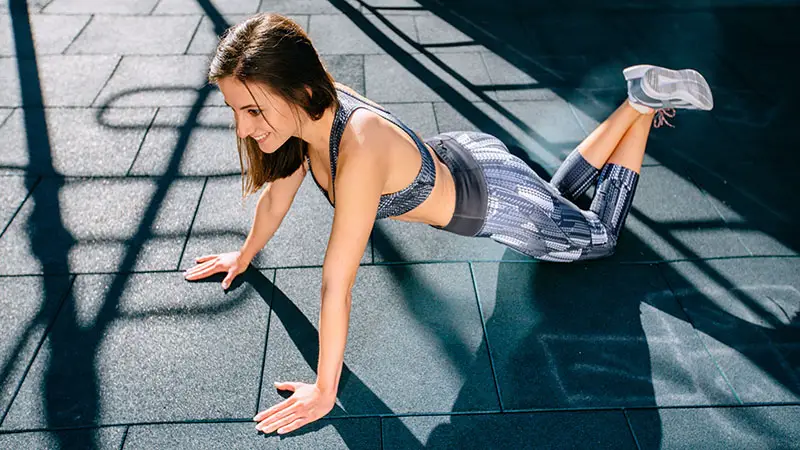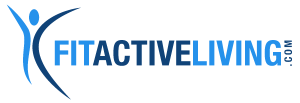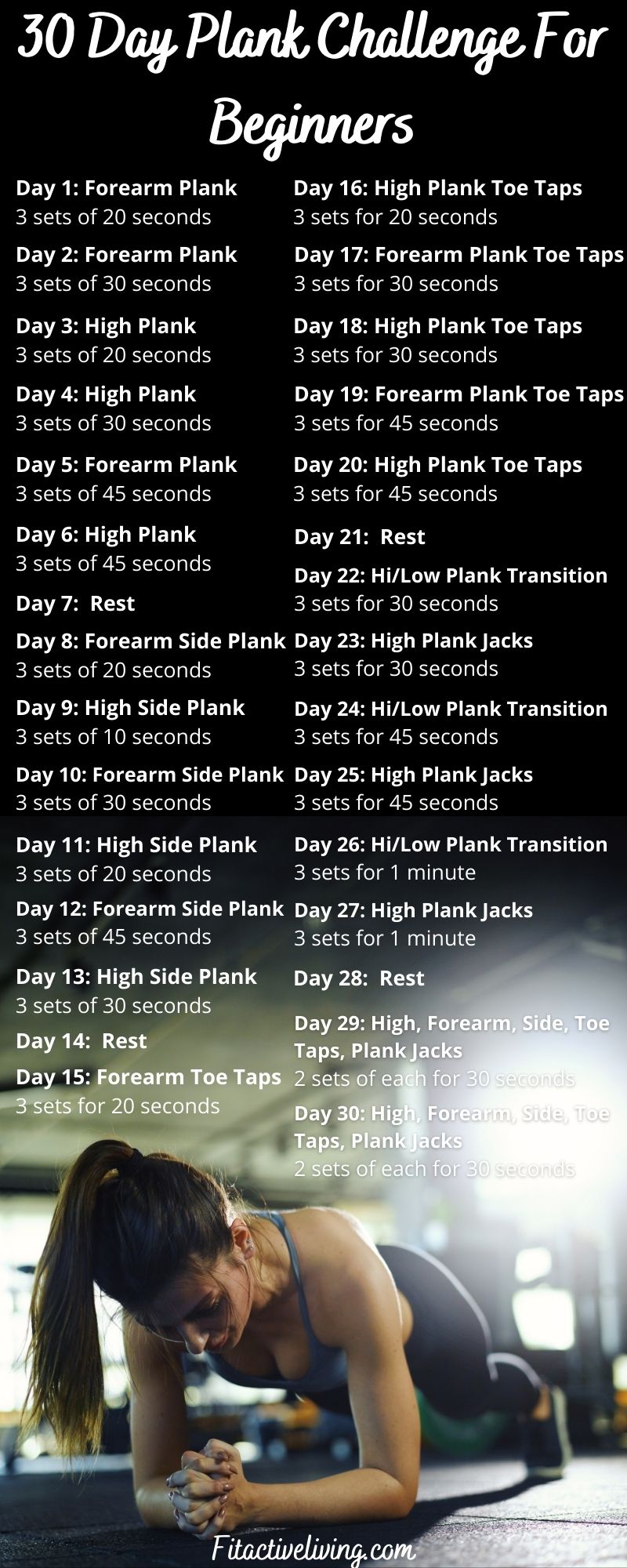Think about the last time you did something for thirty days straight (other than sleep, eat, and go to the bathroom). For many people, this is a tough question to answer. So for fitness challenges, it is easy to see how, for some, they are exactly that, a challenge.
Contents
Designed to help push and motivate you into a healthier lifestyle, both mentally and physically, we deem the thirty-day span long enough to see the fruits of your labor. One of the most popular themes that you can find at your local gym or online is a 30 day plank challenge for beginners, which will not only help your core but also impact your entire body if done correctly. One of the most important aspects about any 30 Day Challenge is to continue with your commitment to exercise once the 30 days expires. Otherwise, all of your hard work will be for nothing.
Plank Challenge For Beginners
As one of the best bodyweight exercises, the plank is a foundation for many functional movements that we do during our day. By engaging in plank-related exercises, you will help to build your core muscles, which are a complex group of major and minor muscles, including your rectus abdominis, transverse abdominis, erector spinae, pelvic floor muscles, obliques, lats, and pectorals. In basic terms, your abs, lower back, muscles on the sides of your spine, and the sides of your abdomen. By strengthening these muscles, you will improve your balance, stability, posture, and ability to move and react quicker.
The great thing about plank exercises is that you can do them with no equipment (other than a timer and maybe a mat or towel) and virtually anywhere that you can find enough space to lay your body out. At the park, beach, garage, living room, or even at work, there should be no excuse why you cannot take part in a 30 day plank challenge for beginners.
While there are several variations to 30 Day Challenges, with the most basic being to extend time or increase reps of a simple exercise, admittingly that can get boring. Although there is absolutely nothing wrong with going basic, some people get bored halfway through and just give up their commitment completely. For our 30 Day Plank Challenge For Beginners, we will mix in a few variations in order to challenge you both mentally and physically.
Planks Used In Our 30 Day Plank Challenge For Beginners
Rest 30-60 seconds between each set as needed in order to make sure you maintain strength and proper form.
Low or Forearm Plank

- Start on your hands and knees. Place your forearms on the floor with your shoulders stacked on top of your elbows. Keep your arms parallel, do not clasp your hands together.
- Extend your legs straight out behind you. Place your feet no wider than hip-width apart (the closer together, the greater difficulty to balance). Engage your core so your hips don’t sag and your butt doesn’t extend in the air. Keep a straight line from your head, back, and feet.
High Plank or Straight Arm Plank

- Start on your hands and knees. Place your hand straight under your shoulders, fingers pointed forward.
- Extend your legs straight out behind you. Place your feet no wider than hip-width apart (the closer together, the greater difficulty to balance). Engage your core so your hips don’t sag and your butt doesn’t extend in the air. Keep a straight line from your head, back, and feet.
Forearm Side Plank

- Lie on one side with your legs extended, stacking your feet on top of each other. If this is too difficult, you can stagger one behind the other for better balance.
- Place your forearm on the floor with your elbow stacked under your shoulder and your palm face down on the floor.
- Elevate your hips so your body creates a straight line from shoulders to feet. Place your top hand on your hip or you can extend your arm straight up in the air.
High-Side Plank

- Assume the same position as the forearm plank, but instead of resting on your forearm, position your hand directly in line with your shoulder and balance on your single arm.
Forearm / High Plank Toe Taps
- Start in a basic forearm or high plank position. Extend one foot out to the side (approx. two feet from the starting spot) and tap your toe on the floor. Return to the starting form and repeat with the other foot.
High / Low Transition Planks
- Start in a high plank position. Slowly drop one arm down to a low plank position and then drop the other arm.
- Make sure that you do not allow your hips to rotate and wiggle too much during the transition.
- Reverse the movement, extending one arm (the same one you dropped first) into a high plank position and then the other.
- On your next set, start the pattern with your opposite hand.
High Plank Jacks
- Start in a high plank position
- Hop both feet in and out in a jumping jack motion, keeping your core and your upper body firm.
- Do not allow your hips to sag or your butt to elevate in the air.
30 Day Plank Challenge For Beginners Downloadable:
(Click to here to save below jpg image or here for pdf)
Benefits Of A 30 Day Plank Challenge For Beginners
Core
While everyone would love to have a six-pack washboard stomach, it’s not always possible and certainly won’t happen within a month, as there are other factors that come into play. However, building strength in your core will have a positive impact on your daily activities. Plank exercises help to work multiple muscles in your core area, including your rectus abdominis, transverse abdominis, obliques, hips, and back.
Full-Body Workout
Most people think that planks just target your core muscles, but in fact, they are a full-body exercise, working both major and small muscle groups you may not realize. From your wrists through to your shoulders, planks demand that you use your forearms, biceps, triceps, and shoulders. With your body fully engaged, you will also notice that you are using your neck, glutes, quads, thighs, calves, and ankles.
Foundation Exercise
If you are new to plank exercises, chances are you are also new to working out your entire body. Exercises such as push-ups, squats, lunges, and various yoga positions can all be made easier with a stronger core and familiarity with plank positions.
Improved Posture
As planks engage your entire body, focusing specifically on your spine, abdominals, rhomboid, and trapezius, increasing strength in these areas will result in improved posture as these muscles keep your shoulders and back in a neutral position while you sit, stand and walk. With improved posture, it will help to prevent injuries because of improper weight distribution and will also help display self-confidence as you will carry yourself upright.
Improved Balance and Flexibility
Each variation of plank creates a different balance challenge depending on the placing of your hands, body, and feet. From riding a bike to dancing to walking, stabilization comes from a strong core. By engaging in various core exercises, your body learns how to work together from head to toe. As you improve your time and increase your challenge, you will build endurance and balance during tiring situations.
As you extend your upper and lower body into various forms of plank, you may notice that it is a great way to stretch. From your arms, to lower back, side body, and even the arches on your feet, planks are both a great exercise to improve both balance and flexibility, which impact each other.
Increased Metabolism
By adding a plank series to your daily routine, you will help strengthen the major muscle groups, which, when done every day, will help burn more calories than most other core exercises. Burning between two to five calories per minute of static plank, by using and building multiple muscle groups, your body will burn more energy, even when you are sedentary.
Mental Health and Focus
Anxiety, stress and attention span. Humans have a lot of things playing into their mental state. Exercise, including planking, can help eliminate some of these personal issues. Working out results in a release of endorphins, which helps us feel good about ourselves, both physically and mentally. As planks target muscle groups that are often stressed and strained, strengthening, stretching, and improving flexibility in these areas helps to eliminate stress and worry.
What Is The Easiest Plank For Beginners?

An isometric exercise, the kneeling plank is one of the easiest forms for beginners as there is no movement involved and there are several parts of the body in contact with the floor to assist with strength and balance challenges. Prior to engaging in the basic forearm or high plank, the kneeling plank is the ideal starting point for beginners.
- Start lying face down on the ground. Prop yourself up on your elbows, which should be stacked in line with your shoulders and at a 90-degree angle. Place your palms face down.
- Engage your core and elevate your upper body off the ground, slightly shifting your weight forward. Keep your knees, shins, and feet on the ground, keeping a straight line from your head through your back, hips, and knees.
- By not holding as much weight off the ground, there will be more stability in your core as the lower body has more support.
- You can alter this plank by holding yourself up in a straight arm / high plank rather than in the forearm position.
Ways To Make The Plank Challenge For Beginners More Challenging
If you do not find this variation of the 30-day plank challenge for beginners challenging enough, there are various ways to make it more challenging.
- Increase the repetitions. There is no need to increase the time as you can do damage to your back, but adding extra reps with proper rest in between is safe.
- Add an incline. Using a step box, yoga blocks, or stairs to place your feet on increases the balance challenge.
- Use a Bosu ball for a stability challenge. Place the flat side on the ground and rest your forearms on the bubble. For an increased challenge, flip the ball over and rest either your hands or feet on the flat surface while maintaining balance.

